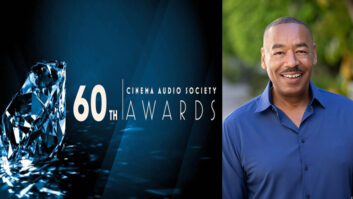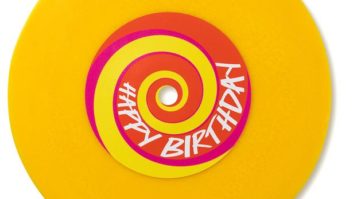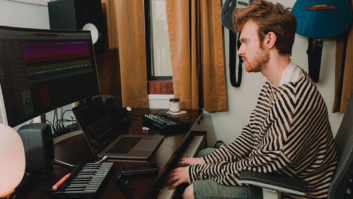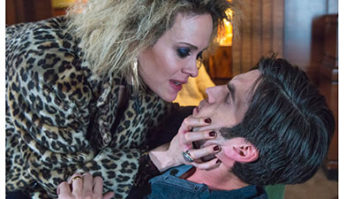The cast of Glee Live sported Crown CM-311 headset mics and JH Audio JH16 earbuds.Rolling into Long Island’s Nassau Coliseum, the Glee Live! In Concert! tour found that its final U.S. show went much like its first, playing to a packed arena full of mostly female teenagers whose collective decibels from nonstop screaming made the sound crew earn its pay.

“We really have to push it over the screaming audience—it gets real loud,” emphasized system engineer Jeff Hargrove as the lights went down for the second gig of the day, the crew having completed a sold-out afternoon matinee just a few hours earlier. While it was the last show of the run, the work was far from over; the next day, the Glee troupe would cross the Atlantic for two shows in Manchester, seven in London and four at the Dublin O2. Apparently, the TV show’s immense popularity travels—and this was no ordinary road show.
Based the top-rated Fox television series which follows the trials and tribulations of singing highschoolers, the tour presented all 14 “student” cast members reprising their TV roles on stage, enacting spectacular productions for each meticulously choreographed song. Audio was supplied by sound company Clair, which also had the same responsibility for the 2010 Glee Live tour. Helming the sound crew this time around was FOH engineer Mark Dowdle, a live-show veteran, having mixed Gloria Estefan for 24 years as well as Elton John, Tina Turner, Mötley Crüe and numerous others.
“We have 17 trucks, 14 buses, three stages and a lot of personnel: 90 people, not counting the talent, managers and security,” said Dowdle. In the business since 1975, he couldn’t guess how many times he’d worked in Nassau Coliseum over the years, but looking around the room, commented, “Most of the rooms on this tour are a fairly similar size; it’s all arenas. Some smaller and some much, much larger, but on average, about the same size: 15,000-18,000. A bunch of the dates have had matinees, and we’ve had to get started in the wee hours of the morning to get it all up and in place in time.”
A Glee-ful audio crew (l-r): Michael Robertson, Roger Niederberger, Jeff Hargrove, Scott Evans, Jerry Harvey, Mark Dowdle.The first arena was the 12,000-seat Mandalay Bay Event Center in Las Vegas, where the tour kicked off with a pair of shows; the sound crew and band rehearsed there for two weeks, before being joined by the case for another two weeks of preparation.

That month gave Dowdle ample opportunity to get used to the Studer Vista 5 console at FOH, which he was using for the first time: “I had an chance to try it in the shop about six months ago, and liked it from a functionality standpoint. I was told that it sounded really good, as far as digital consoles are concerned, so I thought I’d give it a try. It turned out to be a great console.”
Dowdle was also using the Shure KSM-313 dual-voice ribbon mic for the first time. “I decided to experiment a little bit, and it paid off—it’s a great-sounding mic,” he reported. “It takes 140 decibels of sound pressure before it does anything derogatory. I tried it on the kick drum and was amazed by the response it got, so I tried it elsewhere and I like it there as well. It’s a very versatile mic that can be used in a lot of capacities.”
Glee Live! required two monitor engineers: Jerry Harvey, who mixed the cast; and Dan Horton, who handled the band. The monitor engineers both used DiGiCo SD7s positioned next to each other on the left wing of the main stage. Harvey admitted to being initially skeptical about using a digital console, categorizing himself as “an analog guy,” but was sold once he got up to speed: “It’s all about audio quality. If it didn’t sound good, I wouldn’t use it.”
With any console, sound is the top priority, but the support behind it runs a close second—as Horton experienced first-hand. Just a few hours earlier, during the Nassau Coliseum matinee, Horton’s SD7 began dropping out intermittently throughout the concert. While it was transparent to the audience, he was understandably concerned how the desk would perform during the evening show. Afterwards, Horton recalled, “I spoke with DiGiCo’s main technical support rep, opened the console, checked certain points for certain voltages, ended up cleaning the main power supply connections and didn’t have any problem for the second show. Actually, the entire tour was incredibly smooth—I only had that one voltage issue and other than that, it was smooth sailing.”
Fortunately, the issue didn’t happen two nights earlier when the tour played the Izod Center in East Rutherford, NJ; that show was filmed for a Glee Live! 3D concert movie that hit theaters on August 12. The shoot was tackled by the same film crew and cameras used for James Cameron’s Avatar, and Music Mix Mobile handled the recording, which was overseen in the mobile truck outside the arena by engineer Jay Vicari.

“We brought in a separate splitter and gave them every input that we had on stage, so they got it all,” Dowdle recalled. With so many voices needing to be heard clearly in Glee’s trademark harmonies, the FOH system used 84 channels. Effects- wise, Dowdle didn’t use anything unusual: “Just my regular effects: some delay, some reverb, some vocal-enhancement type of effects.”
Between microphones and personal monitors, there was plenty of wireless equipment on hand. Shure KSM9s and Crown CM-311 headsets were a necessity for the vocalists, said Dowdle, explaining, “There’s a lot of movement going on between what talent’s doing when, where and how. Wireless is imperative.”
Meanwhile, the JH16 monitors worn by the 14 singers on stage were custom-molded earbuds manufactured by JH Audio, which is owned by Harvey. Discussing the mix that he sent through them, he offered, “It’s kind of like TV meets a live Broadway show meets a live rock show. It’s not your normal rock band mix, but more of a CDquality mix. Everybody gets a stereo mix with the vocal on top. Sometimes the whole cast is out there, and other times they’re doing duets, so there are lots of cues. They go from singing and performing to lots of skits, but we’ve got it programmed and all dialed in.”
While the performers on stage heard themselves via personal monitors, the crowd heard them via the Clair I-5 line arrays above the stage, with main hangs going 14 deep, while I-3 hangs on the sides ran 12 deep. For the shows at London’s O2 Arena, which holds a seating capacity of 20,000, the I-5s were hung 20 deep in front and 12 deep on the sides. “That’s the biggest on this tour,” said Dowdle, who noted he’s listed in the Guinness Book of World Records for mixing on the biggest PA in 1988 for David Lee Roth’s “Monsters of Rock” show in England’s Donington Park.
Dowdle was a drummer during his teenage years in eastern Ohio, and played in local bands in high school. “I was always the one who ended up taking care of the audio needs,” he recalled. “It just kind of evolved from me doing that into this.” The industry has changed immensely in the years since then, and he admitted that technology is “a lot to keep up with. You have to evolve it, or you’ll be left behind. So far, I’ve been able to do that successfully.” For anyone contemplating a pro audio career, Dowdle recommends developing “an ear for audio and a talent for multitasking and logistics—things of that nature. It’s not for everyone; it can be life-changing, but I like what I do and find it fulfilling.”
Asked which songs in the Glee show were their favorites to mix, both Dowdle and Harvey picked the Aretha Franklin song “Ain’t No Way,” sung by Amber Riley, who plays Glee’s character Mercedes. “That’s very well done,” said Dowdle, to which Harvey added, “She just slays it every night.” Judging from the screaming audience later that evening, the final U.S. concert was no exception.
Clair
clairglobal.com
Studer/JBL Professional
harman.com
Shure
shure.com
JH Audio
jhaudio.com
vitalstats
Glee Live
Clair (Lititz, PA)
FOH Engineer:
Mark Dowdle
Monitor Engineers:
Jerry Harvey, Dan Horton
Systems Engineer:
Jeff Hargrove
RF/Monitor Tech:
Scott Evans
Monitor Tech:
Mike Robertson
FOH Console:
Studer Vista 5
Monitor Console:
(2) DiGiCo SD7
House Speakers:
Clair i-5, i-3
Monitor Speakers:
Clair SRM, ML-18
Personal Monitors:
JH Audio JH7, Ultimate Ears UE-11, Sensaphonics 2max, Sennheiser 2000
House Amplifiers:
Lab.gruppen 2000
FOH Equipment/Plug-Ins:
Lexicon 960L; TC Electronic 2290; Eventide DSP4000, H3000 SE; AMS RMX 16
Microphones:
Shure KSM9, KSM313 ribbon; Crown CM-311 headsets






